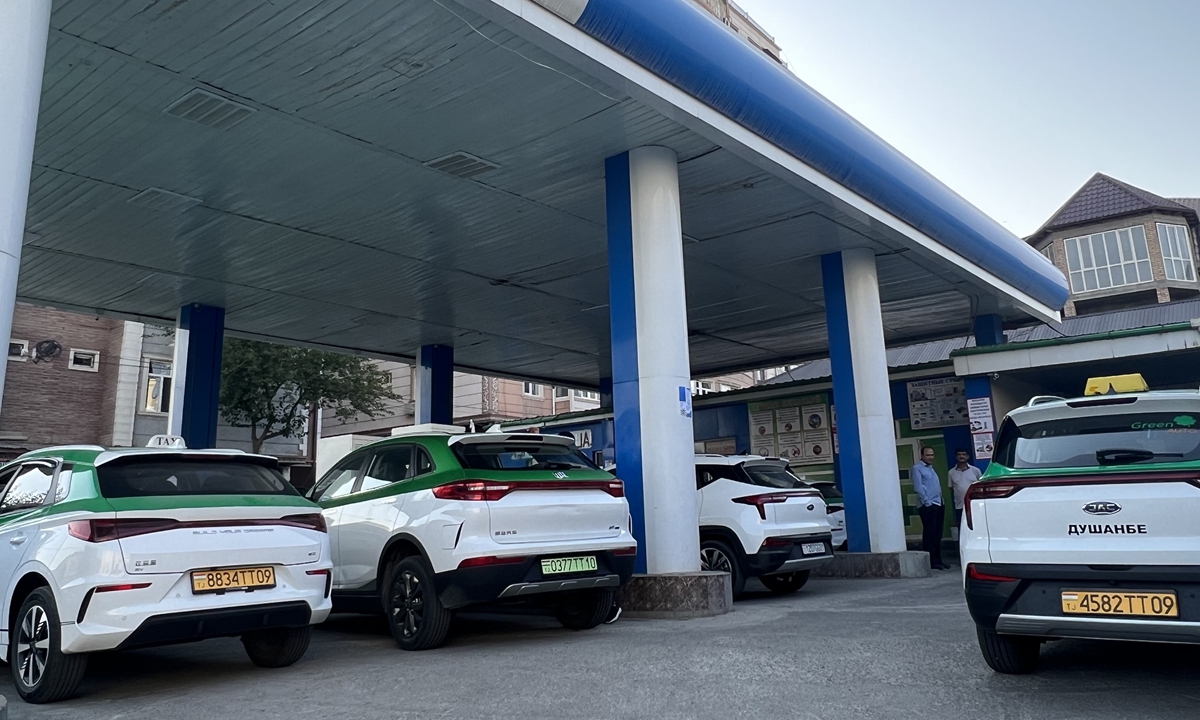
A view of Dushanbe, capital of Tajikistan on July 4, 2024 Photo: Li Xuanmin/GT
Walking in downtown Dushanbe, capital of Tajikistan, one can easily see a steady stream of Chinese new-energy vehicles (NEV) including models from BYD, Geely and BAIC Group motoring smoothly along the city's bustling streets. It is no surprise then, that if one randomly hails a taxi, you find you are stepping into a China-made NEV, their drivers more than happy to share how comfortable the ride is, and how easy and cost-effective they are to drive.
Chinese-made NEVs, as well as solar panels and other photovoltaic (PV) products, are gaining a foothold not just in Tajikistan. In adjacent Central Asia markets such as Uzbekistan and Kazakhstan, Chinese companies - aligning with the region's green transformation target - have been doubling down on exports as well as investing in building local factories or have plans to do so.
Capacity cooperation in the new energy sector is palpably emerging as one of the bright spots between China and Central Asia. Those collaborations, leveraging China's overwhelming edge across the new energy industry chain, will help resource-rich Tajikistan to tap its development potential in wind power, solar power and hydropower, company representatives said. They also serve as a fresh piece of evidence to refute certain Western countries' slandering China for overcapacity in manufacturing new energy products.
"We Tajiks like electric vehicles (EVs). Tajikistan does not produce oil, so buying an EV is more cost effective compared with gasoline cars. It only costs dozens of somonis to charge an EV per time. And almost all the EVs in the Tajik market are produced by Chinese carmakers," Shermatov Romazon, an auto sales manager and translator at a vehicle store in the capital of Dushanbe, told the Global Times.
The store opened two months ago and has sold nearly 50 Chinese EVs. According to the manager, the best-selling Chinese EVs are priced around $20,000 to $30,000.
Husen, in his 20s, bought a BYD vehicle in recent days. He told the Global Times as some of his friends have bought Chinese EVs, he followed suit. "It's comfortable to drive a Chinese EV, and I think I also look stylish when driving it," he said.
The two Tajiks debunk the recent Western overcapacity hype targeting China's new energy industry, stressing that as demand for EVs is picking up rapidly in Tajikistan, supply market still lags behind, especially for affordable car models.
In Central Asia's largest economy Kazakhstan, Chinese companies are witnessing an ever-expanding role in green transition efforts. Kazakhstan aims to establish the green economy as a key principle of its economic policy and has set a target for the share of renewable energy to rise to 15 percent by 2030.
"The vogue for Chinese electric cars in the Central Asian region underscores the competitiveness and global influence of Chinese technologies," Chinese commercial vehicle producer Yutong Bus Co said in a statement sent to the Global Times. Yutong had exported more than 200 new energy buses to Kazakhstan by the end of 2023, and the volume of exports is seeing a steady uptick year-on-year.
Chinese companies highly value the development potential of Central Asia's NEV market, and they plan to introduce more Chinese NEVs and technologies to the region including Kazakhstan, and scale up relevant investments, Gu Chaogang, CEO of Chinese company Genertec Vehicles, told the Global Times.
Genertec Vehicles has established a collaborative relationship with Kazakh vehicle company Allur Group, and has exported more than 7,000 units of car parts to Kazakhstan to date.
The company will bring more tailored-made NEVs that meet requirements for the local intense-cold environment, while also actively promoting related industrial chain development in areas like lithium resources, batteries and new energy charging infrastructure, according to Gu.
In addition to NEVs, new energy capacity cooperation between China and Central Asia has shifted to become deeper and broader, covering a fully-fledged industrial chain including new energy equipment manufacturing, wind power and photovoltaic, which all yields a high-level of mutually beneficial results, business representatives said.
"Made-in-China products have advantages in cost control, which adds even more to the allure of our products," Li Xiaopeng, head of Central Asia representative office of the distributed business group under Chinese PV firm LONGi Green Energy Technology Co, told the Global Times.
Taking into account that Central Asia has abundant solar energy resources, LONGi's PV unit exports to the region since 2021 have surpassed 2 gigawatts to date, and demand is picking up rapidly, Li said.
In the hydropower and wind field, a variety of projects undertaken by Chinese companies such as Power Construction Corporation of China have been supplying stable green electricity to Central Asian countries, a company spokesperson told the Global Times.
He gave the example of the Zhanatas Wind Power Plant in Kazakhstan, which is the largest of its kind in Central Asia in terms of capacity.
The plant, a key project of China- Kazakhstan capacity cooperation under the Belt and Road Initiative, has a designed capacity of 100 megawatts and was connected to the grid in June 2021. The project not only largely alleviates the pressure of electricity demand in southern Kazakhstan, but also contributes to the country's de-carbonization push as it saves 110,000 tons of standard coal annually.
"The prospect of strengthened cooperation between China and Central Asia in new energy is very promising. First, all five Central Asian countries have joined the China-proposed BRI, and clean energy is a priority for BRI capacity cooperation in the new stage of development. Also, both China and Central Asia are dedicated to promoting green development, so this cooperation is conducive to upgrading the energy structure, tackling global climate change and improving people's livelihoods," the PowerChina spokesperson said.
China has maintained its position as the world leader in installed capacity of hydropower, wind power, photovoltaics and ongoing nuclear power construction for years, with renewable energy accounting for over 50 percent of total installed capacity.




